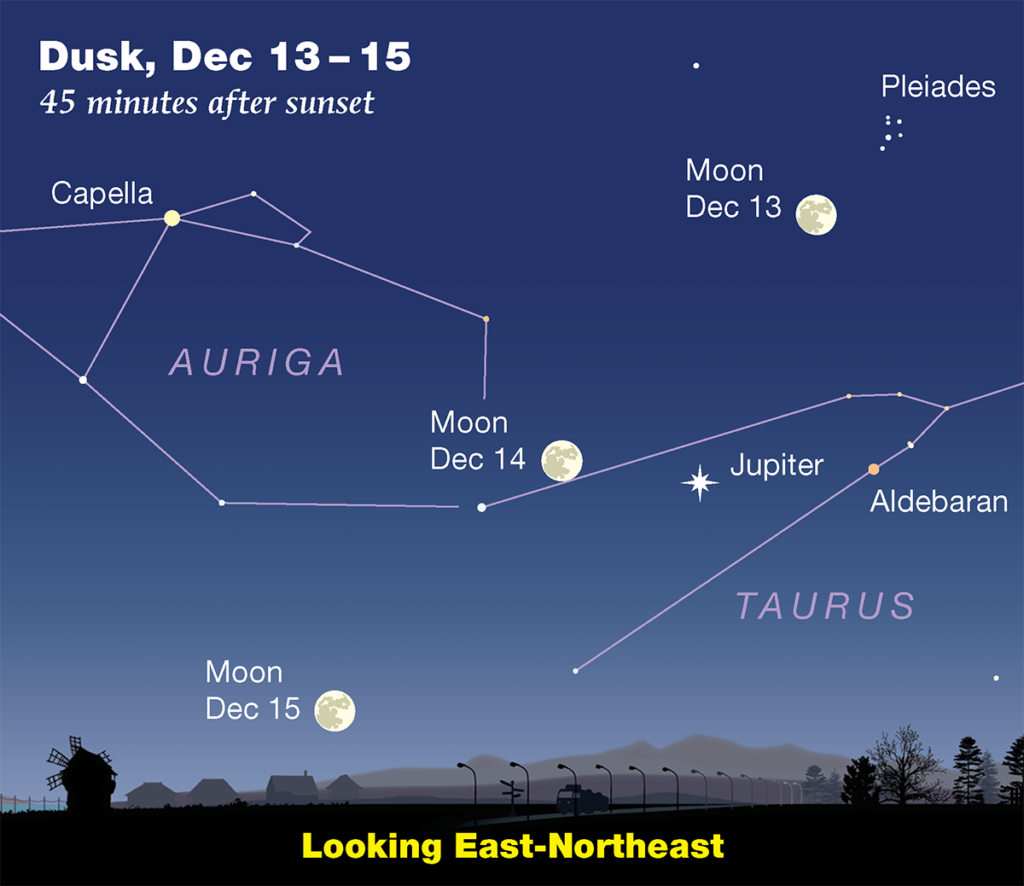
Sunday the moon will be the last full moon of 2024 in the night sky this week. It is called the Cold Moon for obvious reasons. Other names for this moon are the Long Night Moon and the Winter Marker Moon.

As soon as it gets dark, Venus shines in the southwest. As the second brightest object in the night sky, it reigns supreme. Then look opposite in the sky and you see Jupiter in the northeast shining brightly. It is the third brightest object in the night sky.
High in the southwestern sky after dark, Saturn shines prominently in Aquarius setting after Venus. It’s easy to spot as the brightest object in that region. If you have a telescope, this is your chance to marvel at its famous rings.

Jupiter is hanging out between the horns of Taurus the Bull. Jupiter is very bright and relatively close to Earth. Now the first three objects to show up are the Moon, Venus, and Jupiter. The giant gas planet is overhead around midnight. On Saturday the almost full moon will be alongside Jupiter in the east.

Mars joins the show just midnight, rising in Cancer near the bright stars Castor and Pollux in Gemini. As the year wraps up, the red planet will grow brighter, moving closer to Earth in its orbit. On Wednesday Mars will sit to the lower right of the moon.
Mercury appears in the morning sky an hour before dawn. It will be close to the eastern horizon.

As the night unfolds, Vega remains a standout in the west-northwest, with Deneb forming the Northern Cross above it. By 11 PM, the cross will stand upright on the northwest horizon, a beautiful marker of the season.

The Big Dipper to the north is at its lowest point of the year. If you are in Miami, the dipper is below its horizon!

The rising of Orion, Canis Major, and Canis Minor is one of the most magical sights in the winter sky. It starts with Orion, the Hunter, making his grand entrance. You’ll spot his famous belt—three bright stars lined up perfectly in a row. Above the belt is Betelgeuse, a huge red star with a warm, reddish glow, while below it is Rigel, a brilliant blue-white star that shines like a diamond. Orion is hard to miss and is often the first constellation people recognize in the winter.
Not far behind Orion comes Canis Major, the “Greater Dog.” This constellation is home to Sirius, the brightest star in the sky. Sirius steals the show with its intense, bluish-white sparkle. It’s like the sky’s spotlight! In mythology, Canis Major is one of Orion’s loyal hunting dogs, always by his side as he roams the celestial hunting grounds.
Trailing after is Canis Minor, the “Lesser Dog.” It’s a smaller constellation, but it has Procyon, a bright, cheerful-looking star. Even though Canis Minor doesn’t have as many standout stars as Canis Major, it still plays an important role in completing the picture. You can find it a bit to the northeast of Orion, lining up neatly with Sirius and the Hunter’s belt.
When all three rise together, they create an incredible scene. They’re part of what’s called the Winter Triangle, a big pattern of bright stars that lights up the winter night sky. It’s like a natural showcase of some of the most dazzling stars in the heavens, and once you’ve seen it, it’s hard to forget.
Enjoy this stunning celestial lineup throughout the week of December 20! The universe has quite a spectacle in store for us.
